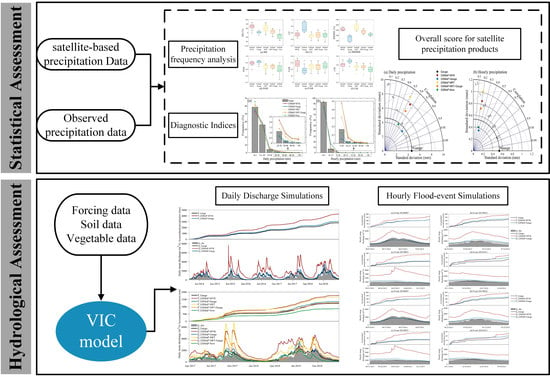Are the Latest GSMaP Satellite Precipitation Products Feasible for Daily and Hourly Discharge Simulations in the Yellow River Source Region?
Abstract
:1. Introduction
2. Study Area and Data Processing
2.1. Study Area
2.2. Ground Weather Data
Satellite Precipitation Products
2.3. Discharge Data
2.4. Geographical Data
3. Methodology
3.1. Diagnostic Indices
3.2. Hydrological Model
3.3. Discharge Simulation Schemes
4. Results
4.1. Statistical Assessment of GSMaP SPPs Versus Ground Precipitation Observations
4.1.1. Spatial Distribution
4.1.2. Satellite Precipitation Estimates at Daily Scales
4.1.3. Satellite Precipitation Estimates at Hourly Scales
4.2. Hydrological Assessment of GSMaP SPPs
4.2.1. Daily Discharge Simulations
4.2.2. Hourly Flood-Event Simulations
5. Discussion
6. Conclusions
- (1)
- The statistical evaluation of the five GSMaP SPPs against the ground precipitation observations demonstrates that GSMaP-Gauge obtains the best overall performance in capturing daily and hourly precipitation dynamics in YRSR, followed by GSMaP-Now and GSMaP-NRT-Gauge, whereas GSMaP-MVK and GSMaP-NRT have inferior performance. All five GSMaP SPPs are less accurate in retrieving hourly precipitation dynamics than in detecting daily processes, indicating that the performance of GSMaP to some extent depends on the accumulation interval of precipitation.
- (2)
- GSMaP-Gauge displays the best hydrological feasibility, which is comparable to the rain-gauge-based data. GSMaP-Now and GSMaP-NRT-Gauge demonstrate basically acceptable hydrological performance in daily streamflow simulations. Both GSMaP-MVK and GSMaP-NRT present inferior capability in daily discharge simulations, with a considerable overestimation of the total streamflow.
- (3)
- The rain-gauge-based precipitation data set presents the best hydrological feasibility in hourly flood simulations but contains considerable errors in total runoff and flood peak flow. The performance of the GSMaP-Gauge-driven flood-event simulation run slightly worsens but is comparable to that of the rain-gauge-based model run. Following GSMaP-Gauge, GSMaP-Now and GSMaP-NRT-Gauge obtain certain predictability of flood events. Overall, GSMaP-MVK and GSMaP-NRT barely have hydrological utility for flood-event simulations.
Author Contributions
Funding
Data Availability Statement
Acknowledgments
Conflicts of Interest
References
- Li, Z.; Yang, D.; Hong, Y. Multi-scale evaluation of high-resolution multi-sensor blended global precipitation products over the Yangtze River. J. Hydrol. 2013, 500, 157–169. [Google Scholar] [CrossRef]
- Huffman, G.J.; Bolvin, D.T.; Nelkin, E.J.; Wolff, D.B.; Adler, R.F.; Gu, G.; Hong, Y.; Bowman, K.P.; Stocker, E.F. The TRMM Multisatellite Precipitation Analysis (TMPA): Quasi-global, multiyear, combined-sensor precipitation estimates at fine scales. J. Hydrometeorol. 2007, 8, 38–55. [Google Scholar] [CrossRef]
- Joyce, R.J.; Janowiak, J.E.; Arkin, P.A.; Xie, P. CMORPH: A method that produces global precipitation estimates from passive microwave and infrared data at high spatial and temporal resolution. J. Hydrometeorol. 2004, 5, 487–503. [Google Scholar] [CrossRef]
- Hsu, K.; Gao, X.; Sorooshian, S.; Gupta, H.V. Precipitation estimation from remotely sensed information using artificial neural networks. J. Appl. Meteorol. 1997, 36, 1176–1190. [Google Scholar] [CrossRef]
- Kubota, T.; Shige, S.; Hashizume, H.; Aonashi, K.; Takahashi, N.; Seto, S.; Hirose, M.; Takayabu, Y.N.; Ushio, T.; Nakagawa, K. Global precipitation map using satellite-borne microwave radiometers by the GSMaP project: Production and validation. IEEE Trans. Geosci. Remote Sens. 2007, 45, 2259–2275. [Google Scholar] [CrossRef]
- Hou, A.Y.; Kakar, R.K.; Neeck, S.; Azarbarzin, A.A.; Kummerow, C.D.; Kojima, M.; Oki, R.; Nakamura, K.; Iguchi, T. The global precipitation measurement mission. Bull. Am. Meteorol. Soc. 2014, 95, 701–722. [Google Scholar] [CrossRef]
- Huffman, G.J.; Bolvin, D.T. Real-Time TRMM Multi-Satellite Precipitation Analysis Data Set Documentation. NASA Tech. Doc. 2015; p. 10. Available online: https://docserver.gesdisc.eosdis.nasa.gov/public/project/GPM/3B4XRT_doc_V7.pdf (accessed on 21 July 2020).
- Tan, J.; Petersen, W.A.; Kirstetter, P.; Tian, Y. Performance of IMERG as a function of spatiotemporal scale. J. Hydrometeorol. 2017, 18, 307–319. [Google Scholar] [CrossRef]
- Gebregiorgis, A.S.; Kirstetter, P.E.; Hong, Y.E.; Gourley, J.J.; Huffman, G.J.; Petersen, W.A.; Xue, X.; Schwaller, M.R. To what extent is the day 1 GPM IMERG satellite precipitation estimate improved as compared to TRMM TMPA-RT? J. Geophys. Res. Atmos. 2018, 123, 1694–1707. [Google Scholar] [CrossRef]
- Anjum, M.N.; Ding, Y.; Shangguan, D.; Ahmad, I.; Ijaz, M.W.; Farid, H.U.; Yagoub, Y.E.; Zaman, M.; Adnan, M. Performance evaluation of latest integrated multi-satellite retrievals for Global Precipitation Measurement (IMERG) over the northern highlands of Pakistan. Atmos. Res. 2018, 205, 134–146. [Google Scholar] [CrossRef]
- He, Z.; Yang, L.; Tian, F.; Ni, G.; Hou, A.; Lu, H. Intercomparisons of rainfall estimates from TRMM and GPM multisatellite products over the Upper Mekong River Basin. J. Hydrometeorol. 2017, 18, 413–430. [Google Scholar] [CrossRef]
- Wang, W.; Lu, H.; Zhao, T.; Jiang, L.; Shi, J. Evaluation and Comparison of Daily Rainfall From Latest GPM and TRMM Products Over the Mekong River Basin. IEEE J. Sel. Top. Appl. Earth Obs. Remote. Sens. 2017, 10, 2540–2549. [Google Scholar] [CrossRef]
- Tang, G.; Ma, Y.; Long, D.; Zhong, L.; Hong, Y. Evaluation of GPM Day-1 IMERG and TMPA Version-7 legacy products over Mainland China at multiple spatiotemporal scales. J. Hydrol. 2016, 533, 152–167. [Google Scholar] [CrossRef]
- Guo, H.; Chen, S.; Bao, A.; Behrangi, A.; Hong, Y.; Ndayisaba, F.; Hu, J.; Stepanian, P.M. Early assessment of integrated multi-satellite retrievals for global precipitation measurement over China. Atmos. Res. 2016, 176, 121–133. [Google Scholar] [CrossRef]
- Xu, R.; Tian, F.; Yang, L.; Hu, H.; Lu, H.; Hou, A. Ground validation of GPM IMERG and TRMM 3B42V7 rainfall products over southern Tibetan Plateau based on a high-density rain gauge network. J. Geophys. Res. Atmos. 2017, 122, 910–924. [Google Scholar] [CrossRef]
- Jiang, S.; Ren, L.; Xu, C.; Yong, B.; Yuan, F.; Liu, Y.; Yang, X.; Zeng, X. Statistical and hydrological evaluation of the latest Integrated Multi-satellitE Retrievals for GPM (IMERG) over a midlatitude humid basin in South China. Atmos. Res. 2018, 214, 418–429. [Google Scholar] [CrossRef]
- Yuan, F.; Wang, B.; Shi, C.; Cui, W.; Zhao, C.; Liu, Y.; Ren, L.; Zhang, L.; Zhu, Y.; Chen, T. Evaluation of hydrological utility of IMERG Final run V05 and TMPA 3B42V7 satellite precipitation products in the Yellow River source region, China. J. Hydrol. 2018, 567, 696–711. [Google Scholar] [CrossRef]
- Li, N.; Tang, G.; Zhao, P.; Hong, Y.; Gou, Y.; Yang, K. Statistical assessment and hydrological utility of the latest multi-satellite precipitation analysis IMERG in Ganjiang River basin. Atmos. Res. 2017, 183, 212–223. [Google Scholar] [CrossRef]
- Zubieta, R.; Getirana, A.; Espinoza, J.C.; Lavado-Casimiro, W.; Aragon, L. Hydrological modeling of the Peruvian–Ecuadorian Amazon Basin using GPM-IMERG satellite-based precipitation dataset. Hydrol. Earth Syst. Sci. 2017, 21, 3543–3555. [Google Scholar] [CrossRef] [Green Version]
- Yuan, F.; Zhang, L.; Win, K.W.W.; Ren, L.; Zhao, C.; Zhu, Y.; Jiang, S.; Liu, Y. Assessment of GPM and TRMM multi-satellite precipitation products in streamflow simulations in a data-sparse mountainous watershed in Myanmar. Remote Sens. 2017, 9, 302. [Google Scholar] [CrossRef] [Green Version]
- Ning, S.; Wang, J.; Jin, J.; Ishidaira, H. Assessment of the latest GPM-Era high-resolution satellite precipitation products by comparison with observation gauge data over the Chinese mainland. Water 2016, 8, 481. [Google Scholar] [CrossRef]
- Zhao, H.; Yang, B.; Yang, S.; Huang, Y.; Dong, G.; Bai, J.; Wang, Z. Systematical estimation of GPM-based global satellite mapping of precipitation products over China. Atmos. Res. 2018, 201, 206–217. [Google Scholar] [CrossRef]
- Tang, G.; Zeng, Z.; Ma, M.; Liu, R.; Wen, Y.; Hong, Y. Can near-real-time satellite precipitation products capture rainstorms and guide flood warning for the 2016 summer in South China? IEEE Geosci. Remote Sens. 2017, 14, 1208–1212. [Google Scholar] [CrossRef]
- Tan, X.; Yong, B.; Ren, L. Error features of the hourly GSMaP multi-satellite precipitation estimates over nine major basins of China. Hydrol. Res. 2018, 49, 761–779. [Google Scholar] [CrossRef]
- Satgé, F.; Hussain, Y.; Bonnet, M.; Hussain, B.M.; Martinez-Carvajal, H.; Akhter, G.; Uagoda, R. Benefits of the successive GPM based satellite precipitation estimates IMERG–V03,–V04,–V05 and GSMaP–V06,–V07 over diverse geomorphic and meteorological regions of Pakistan. Remote Sens. 2018, 10, 1373. [Google Scholar] [CrossRef] [Green Version]
- Saber, M.; Yilmaz, K.K. Evaluation and bias correction of satellite-based rainfall estimates for modelling flash floods over the Mediterranean region: Application to Karpuz River Basin, Turkey. Water 2018, 10, 657. [Google Scholar] [CrossRef] [Green Version]
- Ryo, M.; Saavedra Valeriano, O.C.; Kanae, S.; Ngoc, T.D. Temporal downscaling of daily gauged precipitation by application of a satellite product for flood simulation in a poorly gauged basin and its evaluation with multiple regression analysis. J. Hydrometeorol. 2014, 15, 563–580. [Google Scholar] [CrossRef]
- Saber, M.; Hamaguchi, T.; Kojiri, T.; Tanaka, K.; Sumi, T. A physically based distributed hydrological model of wadi system to simulate flash floods in arid regions. Arab. J. Geosci. 2015, 8, 143–160. [Google Scholar] [CrossRef]
- Sugiura, A.; Fujioka, S.; Nabesaka, S.; Tsuda, M.; Iwami, Y. Development of a flood forecasting system on the upper Indus catchment using IFAS. J. Flood Risk Manag. 2016, 9, 265–277. [Google Scholar] [CrossRef]
- Shahzad, A.; Gabriel, H.F.; Haider, S.; Mubeen, A.; Siddiqui, M.J. Development of a flood forecasting system using IFAS: A case study of scarcely gauged Jhelum and Chenab river basins. Arab. J. Geosci. 2018, 11, 1–18. [Google Scholar] [CrossRef]
- Pham, N.T.T.; Nguyen, Q.H.; Ngo, A.D.; Le, H.T.T.; Nguyen, C.T. Investigating the impacts of typhoon-induced floods on the agriculture in the central region of Vietnam by using hydrological models and satellite data. Nat. Hazards 2018, 92, 189–204. [Google Scholar] [CrossRef]
- Falck, A.S.; Maggioni, V.; Tomasella, J.; Vila, D.A.; Diniz, F.L. Propagation of satellite precipitation uncertainties through a distributed hydrologic model: A case study in the Tocantins–Araguaia basin in Brazil. J. Hydrol. 2015, 527, 943–957. [Google Scholar] [CrossRef]
- Deng, P.; Zhang, M.; Bing, J.; Jia, J.; Zhang, D. Evaluation of the GSMaP_Gauge products using rain gauge observations and SWAT model in the Upper Hanjiang River Basin. Atmos. Res. 2019, 219, 153–165. [Google Scholar] [CrossRef]
- Sun, R.; Yuan, H.; Yang, Y. Using multiple satellite-gauge merged precipitation products ensemble for hydrologic uncertainty analysis over the Huaihe River basin. J. Hydrol. 2018, 566, 406–420. [Google Scholar] [CrossRef] [Green Version]
- Qi, W.; Zhang, C.; Fu, G.; Zhou, H.; Liu, J. Quantifying uncertainties in extreme flood predictions under climate change for a medium-sized basin in northeastern China. J. Hydrometeorol. 2016, 17, 3099–3112. [Google Scholar] [CrossRef]
- Lu, D.; Yong, B. Evaluation and hydrological utility of the latest GPM IMERG V5 and GSMaP V7 precipitation products over the Tibetan Plateau. Remote Sens. 2018, 10, 2022. [Google Scholar] [CrossRef] [Green Version]
- Satgé, F.; Ruelland, D.; Bonnet, M.; Molina, J.; Pillco, R. Consistency of satellite-based precipitation products in space and over time compared with gauge observations and snow-hydrological modelling in the Lake Titicaca region. Hydrol. Earth Syst. Sci. 2019, 23, 595–619. [Google Scholar] [CrossRef] [Green Version]
- Yuan, F.; Zhang, L.; Soe, K.; Ren, L.; Zhao, C.; Zhu, Y.; Jiang, S.; Liu, Y. Applications of TRMM- and GPM-Era Multiple-Satellite Precipitation Products for Flood Simulations at Sub-Daily Scales in a Sparsely Gauged Watershed in Myanmar. Remote Sens. 2019, 11, 140. [Google Scholar] [CrossRef] [Green Version]
- Hu, Y.; Maskey, S.; Uhlenbrook, S. Trends in temperature and rainfall extremes in the Yellow River source region, China. Clim. Chang. 2012, 110, 403–429. [Google Scholar] [CrossRef] [Green Version]
- Ma, X.; Fukushima, Y.; Yasunari, T.; Matsuoka, M.; Sato, Y.; Kimura, F.; Zheng, H. Examination of the water budget in upstream and midstream regions of the Yellow River, China. Hydrol. Process. 2010, 24, 618–630. [Google Scholar] [CrossRef]
- Ren, L.; Jiang, S.; Yuan, F.; Yong, B.; Gong, L.; Yuan, S. Evolution of methodology in hydrology and its explanation. Adv. Water Sci. 2011, 22, 586–592. [Google Scholar]
- Mega, T.; Ushio, T.; Matsuda, T.; Kubota, T.; Kachi, M.; Oki, R. Gauge-Adjusted Global Satellite Mapping of Precipitation. IEEE Trans. Geosci. Remote. Sens. 2019, 57, 1928–1935. [Google Scholar] [CrossRef]
- Hansen, M.C.; DeFries, R.S.; Townshend, J.R.; Sohlberg, R. Global land cover classification at 1 km spatial resolution using a classification tree approach. Int. J. Remote Sens. 2000, 21, 1331–1364. [Google Scholar] [CrossRef]
- Sanchez, P.A.; Ahamed, S.; Carré, F.; Hartemink, A.E.; Zhang, G.L. Digital Soil Map of the World (DSMW); FAO: Rome, Italy, 2003. [Google Scholar]
- Liang, X.; Lettenmaier, D.P.; Wood, E.F.; Burges, S.J. A simple hydrologically based model of land surface water and energy fluxes for general circulation models. J. Geophys. Res. Atmos. 1994, 99, 14415–14428. [Google Scholar] [CrossRef]
- Liang, X.; Wood, E.F.; Lettenmaier, D.P. Surface soil moisture parameterization of the VIC-2L model: Evaluation and modification. Glob. Planet. Chang. 1996, 13, 195–206. [Google Scholar] [CrossRef]
- Todini, E. The ARNO rainfall—Runoff model. J. Hydrol. 1996, 175, 339–382. [Google Scholar] [CrossRef]
- Liang, X.; Xie, Z. A new surface runoff parameterization with subgrid-scale soil heterogeneity for land surface models. Adv. Water Resour. 2001, 24, 1173–1193. [Google Scholar] [CrossRef]
- Liang, X.; Xie, Z. Important factors in land–atmosphere interactions: Surface runoff generations and interactions between surface and groundwater. Glob. Planet. Chang. 2003, 38, 101–114. [Google Scholar] [CrossRef]
- Cosby, B.J.; Hornberger, G.M.; Clapp, R.B.; Ginn, T. A statistical exploration of the relationships of soil moisture characteristics to the physical properties of soils. Water Resour. Res. 1984, 20, 682–690. [Google Scholar] [CrossRef] [Green Version]
- Rawls, W.J.; Brakensiek, D.L. Prediction of soil water properties for hydrologic modeling. Am. Soc. Civ. Eng. 2015, 293–299. [Google Scholar]
- Duan, Q.; Sorooshian, S.; Gupta, V. Effective and efficient global optimization for conceptual rainfall-runoff models. Water Resour. Res. 1992, 28, 1015–1031. [Google Scholar] [CrossRef]
- Duan, Q.Y.; Gupta, V.K.; Sorooshian, S. Shuffled complex evolution approach for effective and efficient global minimization. J. Optimiz. Theory Appl. 1993, 76, 501–521. [Google Scholar] [CrossRef]
- Sharifi, E.; Steinacker, R.; Saghafian, B. Multi time-scale evaluation of high-resolution satellite-based precipitation products over northeast of Austria. Atmos. Res. 2018, 206, 46–63. [Google Scholar] [CrossRef]
- Wang, C.; Tang, G.; Han, Z.; Guo, X.; Hong, Y. Global intercomparison and regional evaluation of GPM IMERG Version-03, Version-04 and its latest Version-05 precipitation products: Similarity, difference and improvements. J. Hydrol. 2018, 564, 342–356. [Google Scholar] [CrossRef]
- Lazin, R.; Shen, X.; Koukoula, M.; Anagnostou, E. Evaluation of the hyper-resolution model-derived water cycle components over the upper Blue Nile Basin. J. Hydrol. 2020, 590, 125231. [Google Scholar] [CrossRef]
- Kim, J.; Han, H. Evaluation of the CMORPH high-resolution precipitation product for hydrological applications over South Korea. Atmos. Res. 2021, 258, 105650. [Google Scholar] [CrossRef]
- Monsieurs, E.; Kirschbaum, D.B.; Tan, J.; Mateso, J.M.; Jacobs, L.; Plisnier, P.; Thiery, W.; Umutoni, A.; Musoni, D.; Bibentyo, T.M. Evaluating TMPA rainfall over the sparsely gauged East African Rift. J. Hydrometeorol. 2018, 19, 1507–1528. [Google Scholar] [CrossRef]
- Wang, D.; Wang, X.; Liu, L.; Wang, D.; Huang, H.; Pan, C. Evaluation of TMPA 3B42V7, GPM IMERG and CMPA precipitation estimates in Guangdong Province, China. Int. J. Climatol. 2019, 39, 738–755. [Google Scholar] [CrossRef]
- Nodzu, M.I.; Matsumoto, J.; Trinh-Tuan, L.; Ngo-Duc, T. Precipitation estimation performance by Global Satellite Mapping and its dependence on wind over northern Vietnam. Progress Earth Planet. Sci. 2019, 6, 1–15. [Google Scholar] [CrossRef] [Green Version]
- Huang, W.; Chang, Y.; Liu, P. Assessment of IMERG precipitation over Taiwan at multiple timescales. Atmos. Res. 2018, 214, 239–249. [Google Scholar] [CrossRef]
- Shi, J.; Yuan, F.; Shi, C.; Zhao, C.; Zhang, L.; Ren, L.; Zhu, Y.; Jiang, S.; Liu, Y. Statistical Evaluation of the Latest GPM-Era IMERG and GSMaP Satellite Precipitation Products in the Yellow River Source Region. Water 2020, 12, 1006. [Google Scholar] [CrossRef] [Green Version]
- Zhao, C.; Ren, L.; Yuan, F.; Zhang, L.; Jiang, S.; Shi, J.; Chen, T.; Liu, S.; Yang, X.; Liu, Y.; et al. Statistical and Hydrological Evaluations of Multiple Satellite Precipitation Products in the Yellow River Source Region of China. Water 2020, 12, 3082. [Google Scholar] [CrossRef]
- Kubota, T.; Aonashi, K.; Ushio, T.; Shige, S.; Oki, R. Recent progress in global satellite mapping of precipitation (GSMAP) product. In Proceedings of the IGARSS 2017-2017 IEEE International Geoscience and Remote Sensing Symposium, Fort Worth, TX, USA, 23–28 July 2017. [Google Scholar]
- Wang, X.; Li, B.; Chen, Y.; Guo, H.; Wang, Y.; Lian, L. Applicability Evaluation of Multisource Satellite Precipitation Data for Hydrological Research in Arid Mountainous Areas. Remote Sens. 2020, 12, 2886. [Google Scholar] [CrossRef]
- Bui, H.T.; Ishidaira, H.; Shaowei, N. Evaluation of the use of global satellite–gauge and satellite-only precipitation products in stream flow simulations. Appl. Water Sci. 2019, 9, 1–15. [Google Scholar] [CrossRef] [Green Version]
- Moulin, L.; Gaume, E.; Obled, C. Uncertainties on mean areal precipitation: Assessment and impact on streamflow simulations. Hydrol. Earth Syst. Sci. 2009, 13, 99–114. [Google Scholar] [CrossRef] [Green Version]
- Habib, E.; Aduvala, A.V.; Meselhe, E.A. Analysis of radar-rainfall error characteristics and implications for streamflow simulation uncertainty. Hydrol. Sci. J. 2008, 53, 568–587. [Google Scholar] [CrossRef]
- Nikolopoulos, E.I.; Anagnostou, E.N.; Borga, M. Using high-resolution satellite rainfall products to simulate a major flash flood event in northern Italy. J. Hydrometeorol. 2013, 14, 171–185. [Google Scholar] [CrossRef]
- David, C.H.; Hobbs, J.M.; Turmon, M.J.; Emery, C.M.; Reager, J.T.; Famiglietti, J.S. Analytical propagation of runoff uncertainty into discharge uncertainty through a large river network. Geophys. Res. Lett. 2019, 46, 8102–8113. [Google Scholar] [CrossRef]
- Xue, X.; Hong, Y.; Limaye, A.S.; Gourley, J.J.; Huffman, G.J.; Khan, S.I.; Dorji, C.; Chen, S. Statistical and hydrological evaluation of TRMM-based Multi-satellite Precipitation Analysis over the Wangchu Basin of Bhutan: Are the latest satellite precipitation products 3B42V7 ready for use in ungauged basins? J. Hydrol. 2013, 499, 91–99. [Google Scholar] [CrossRef]
- Ma, Y.; Tang, G.; Long, D.; Yong, B.; Zhong, L.; Wan, W.; Hong, Y. Similarity and error intercomparison of the GPM and its predecessor-TRMM multisatellite precipitation analysis using the best available hourly gauge network over the Tibetan Plateau. Remote Sens. 2016, 8, 569. [Google Scholar] [CrossRef] [Green Version]
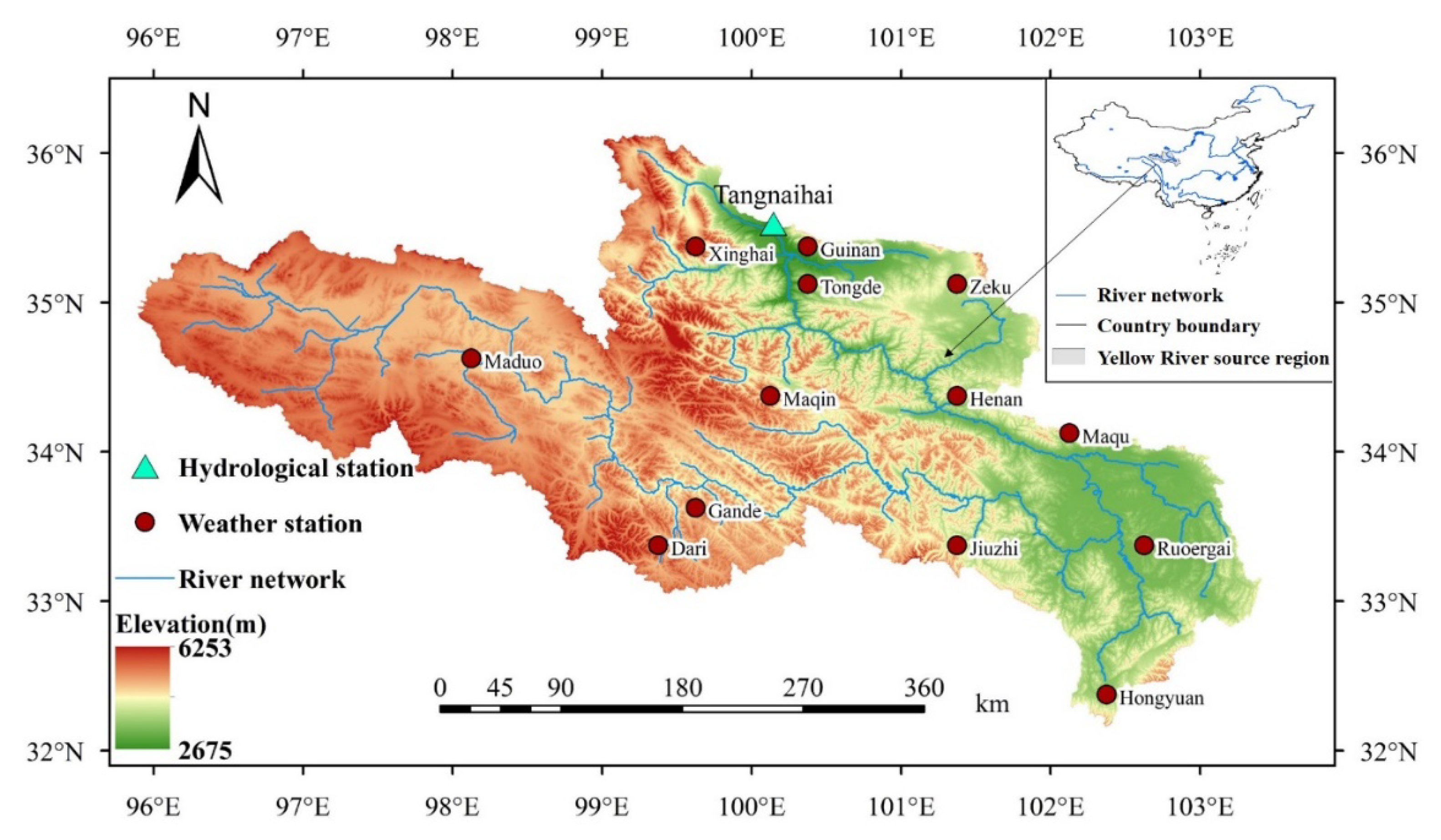

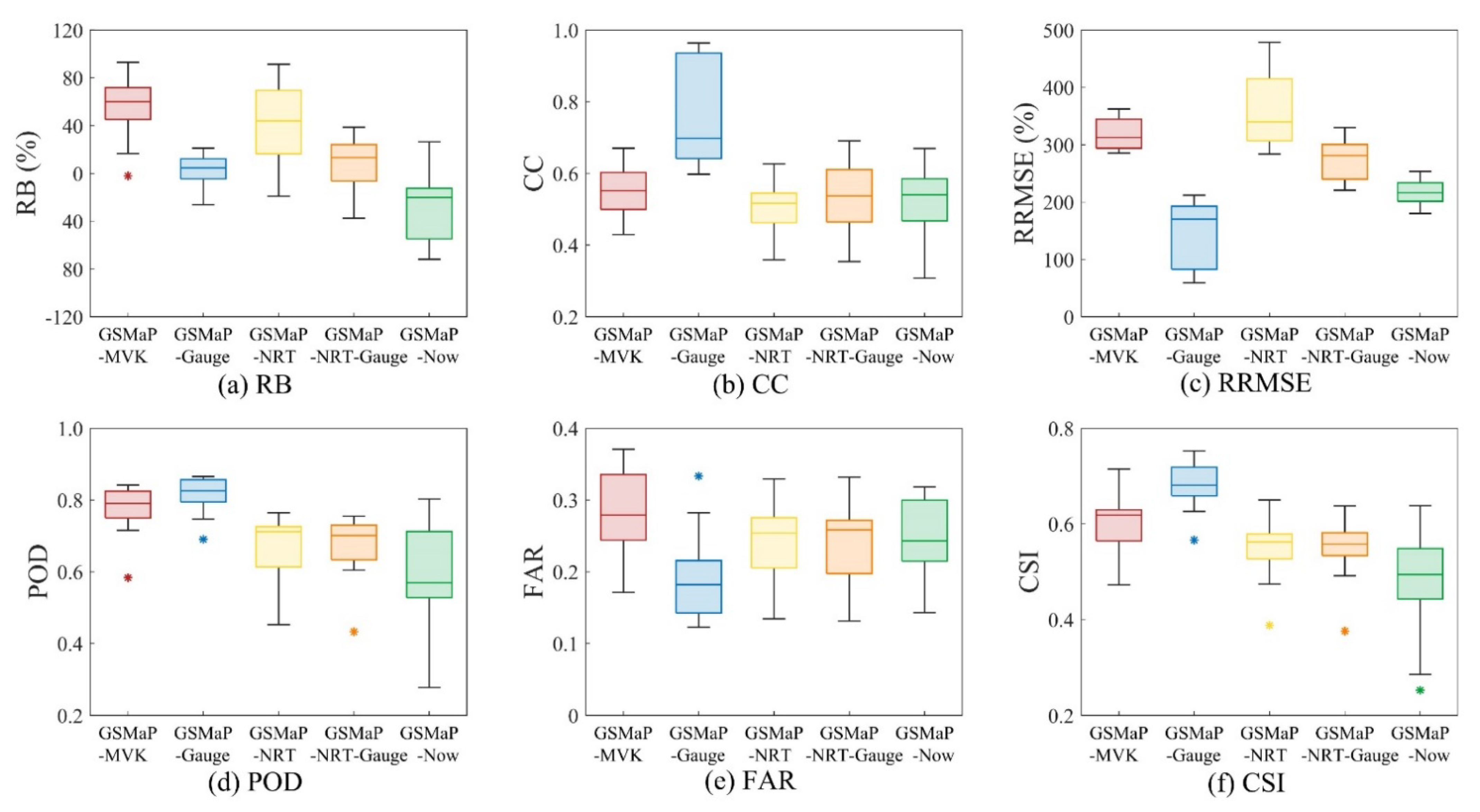
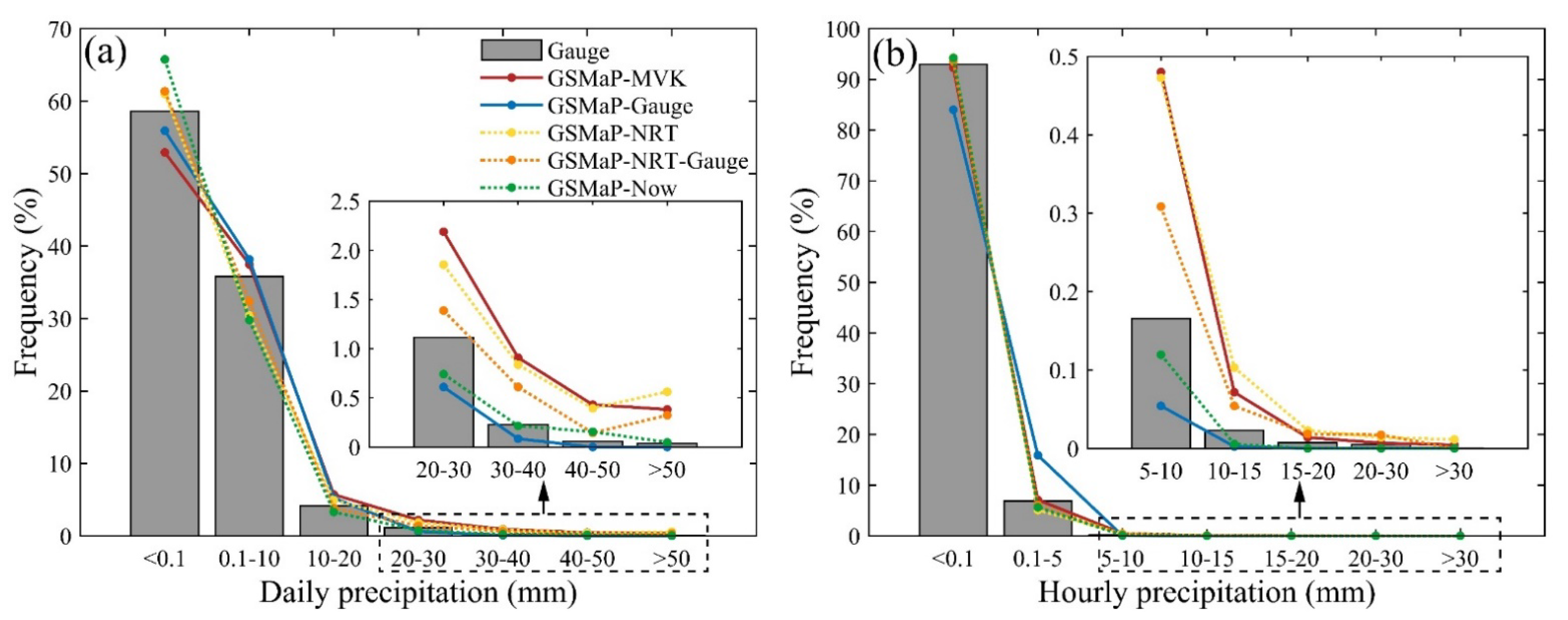
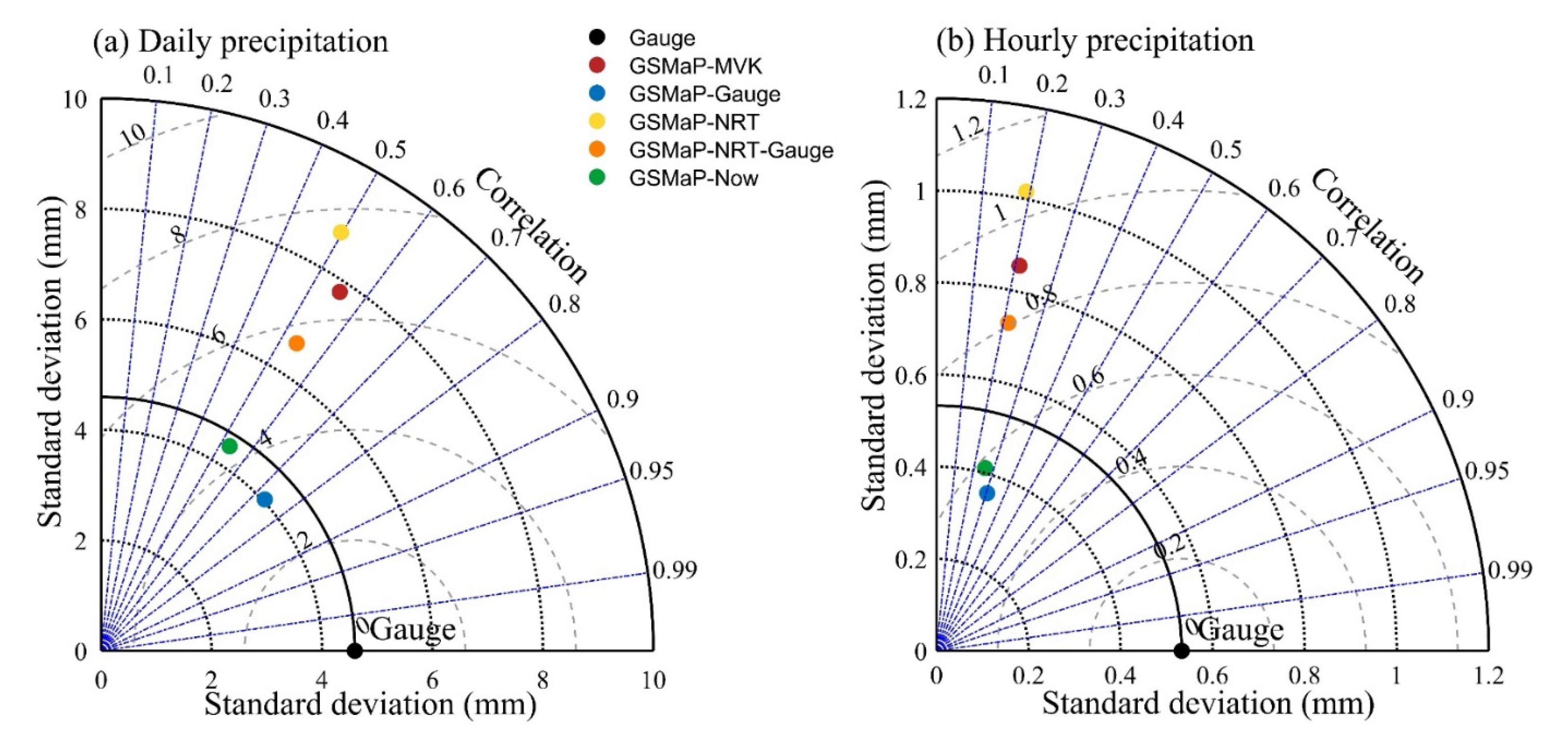
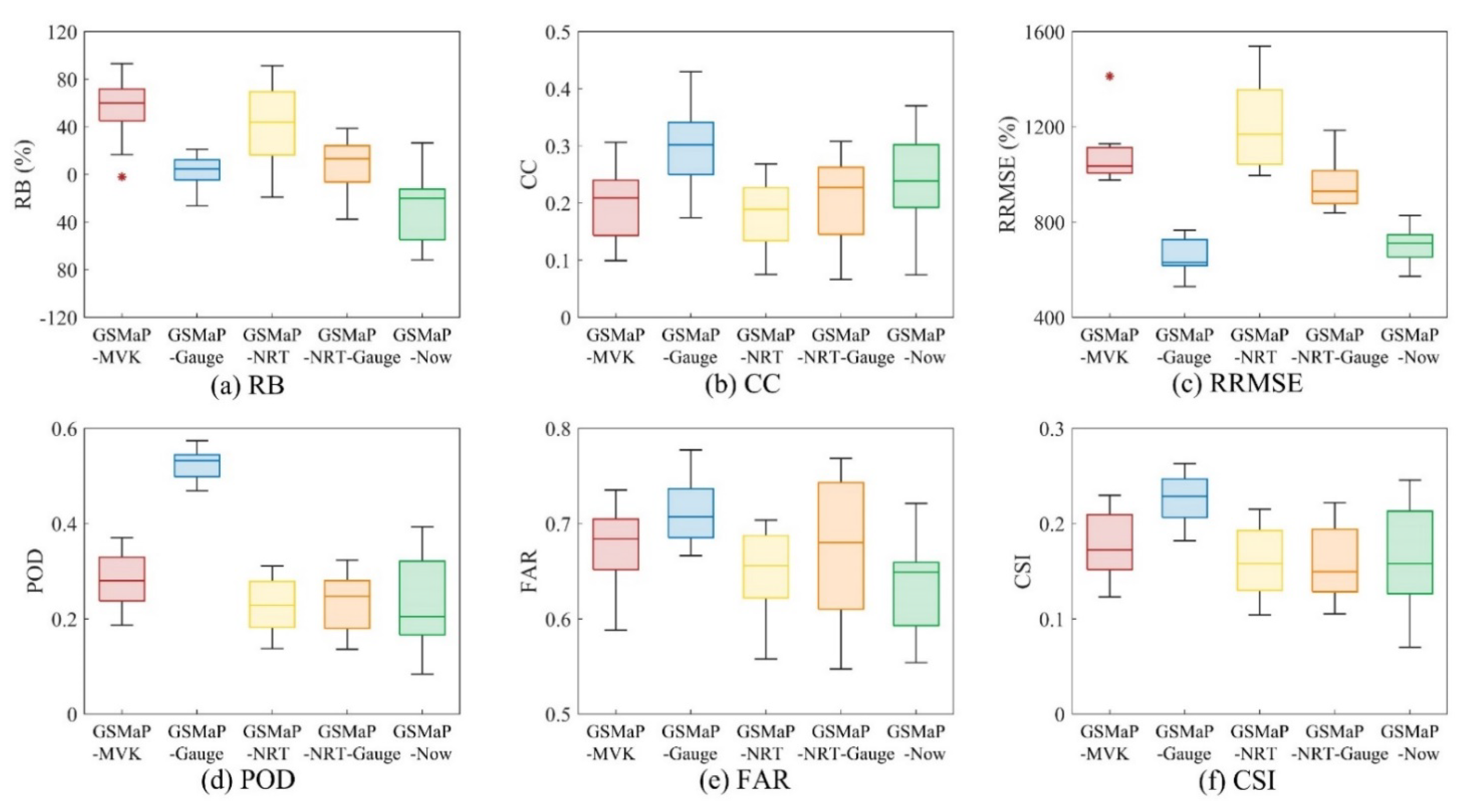
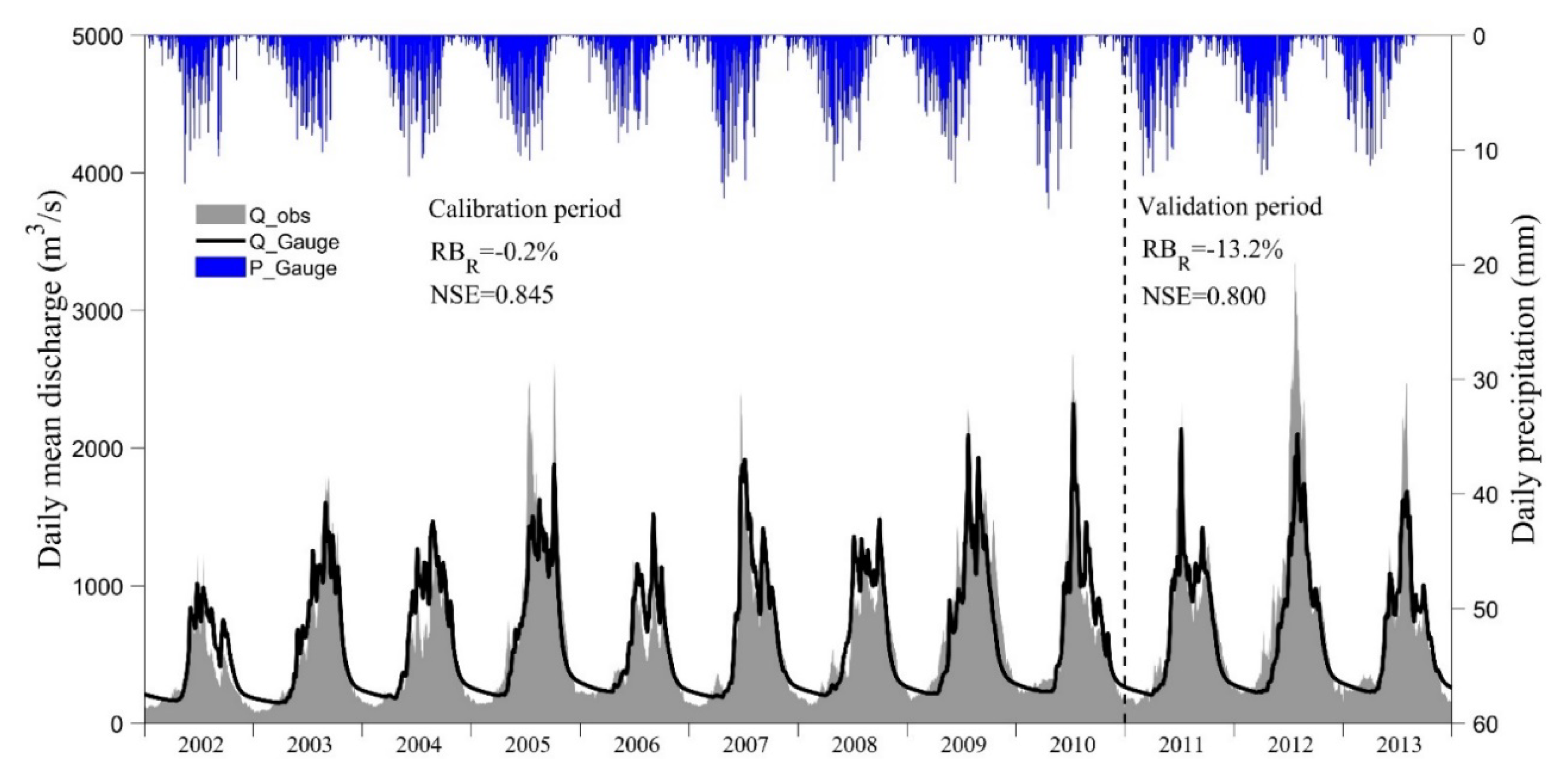

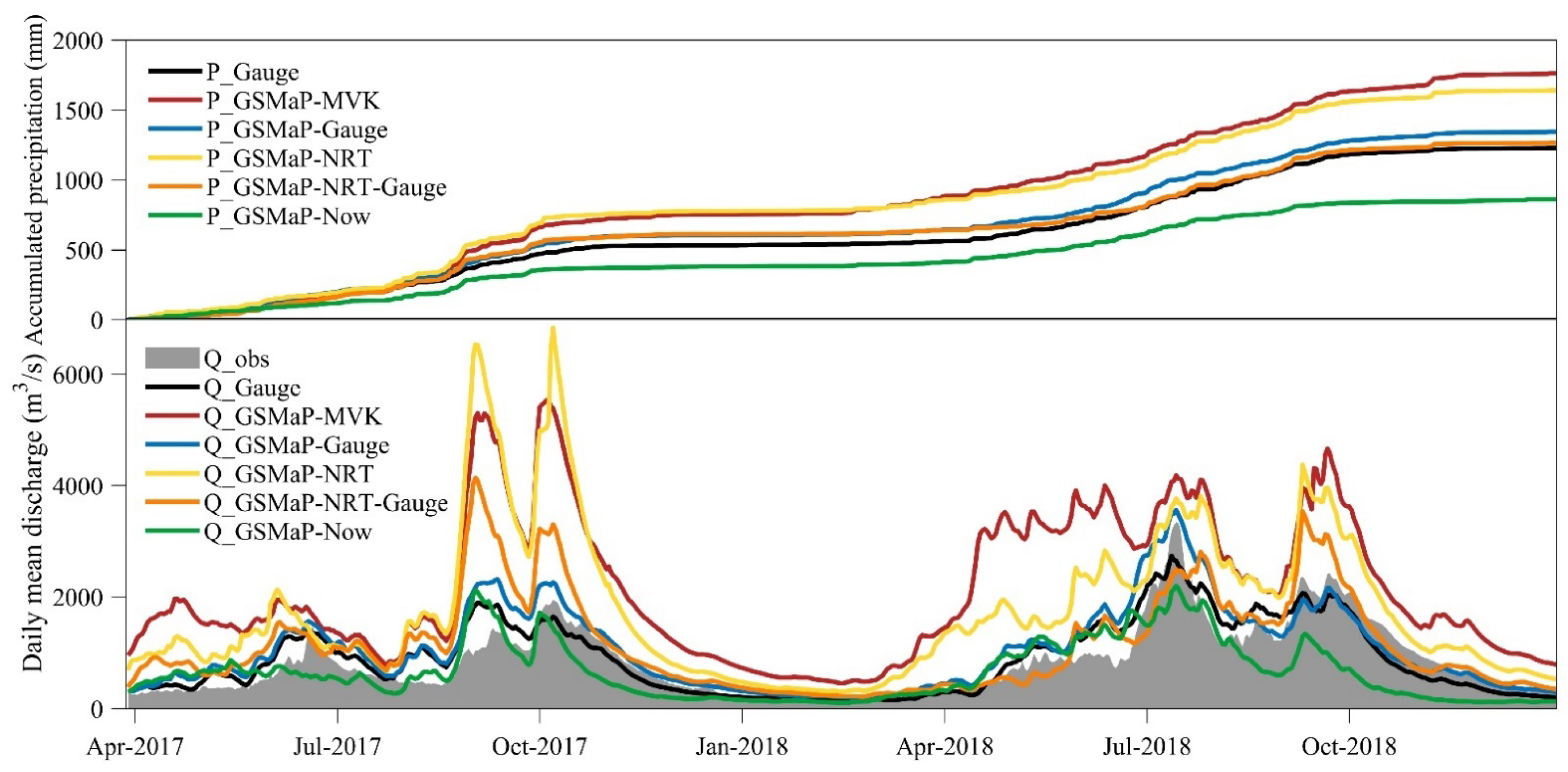
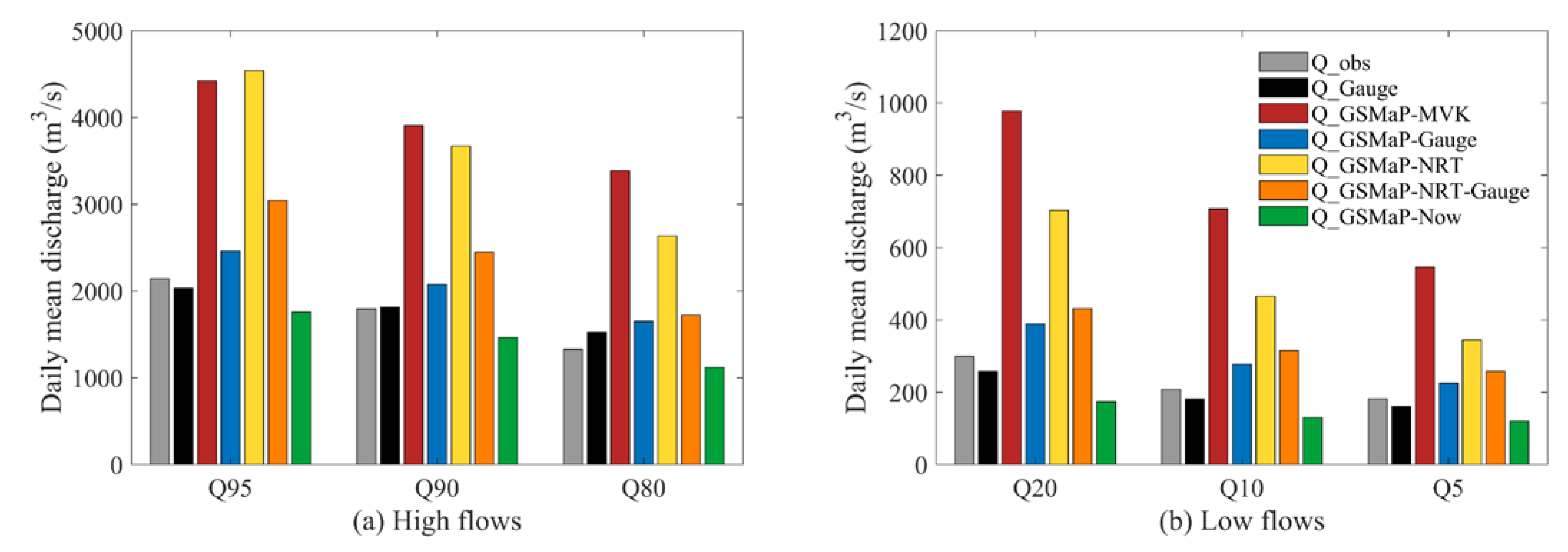


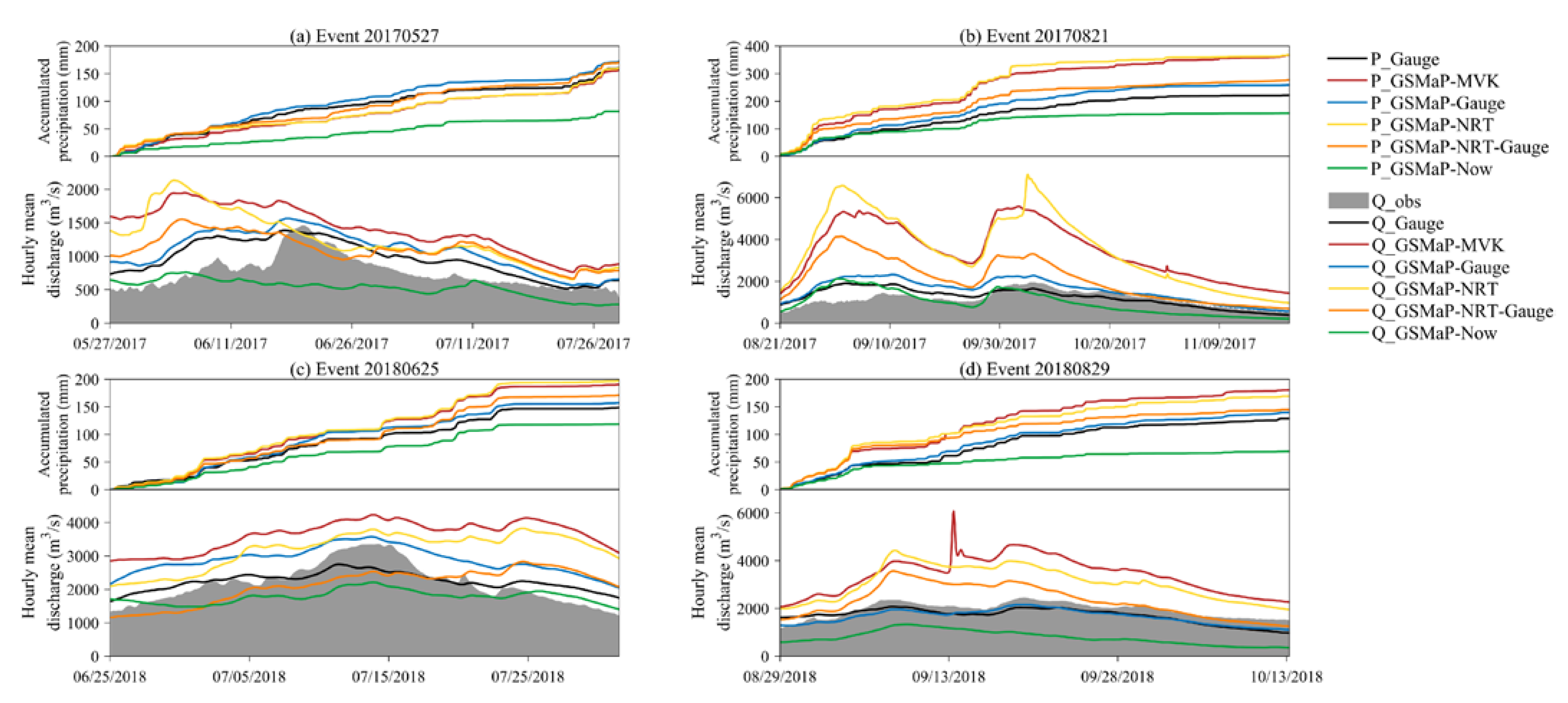
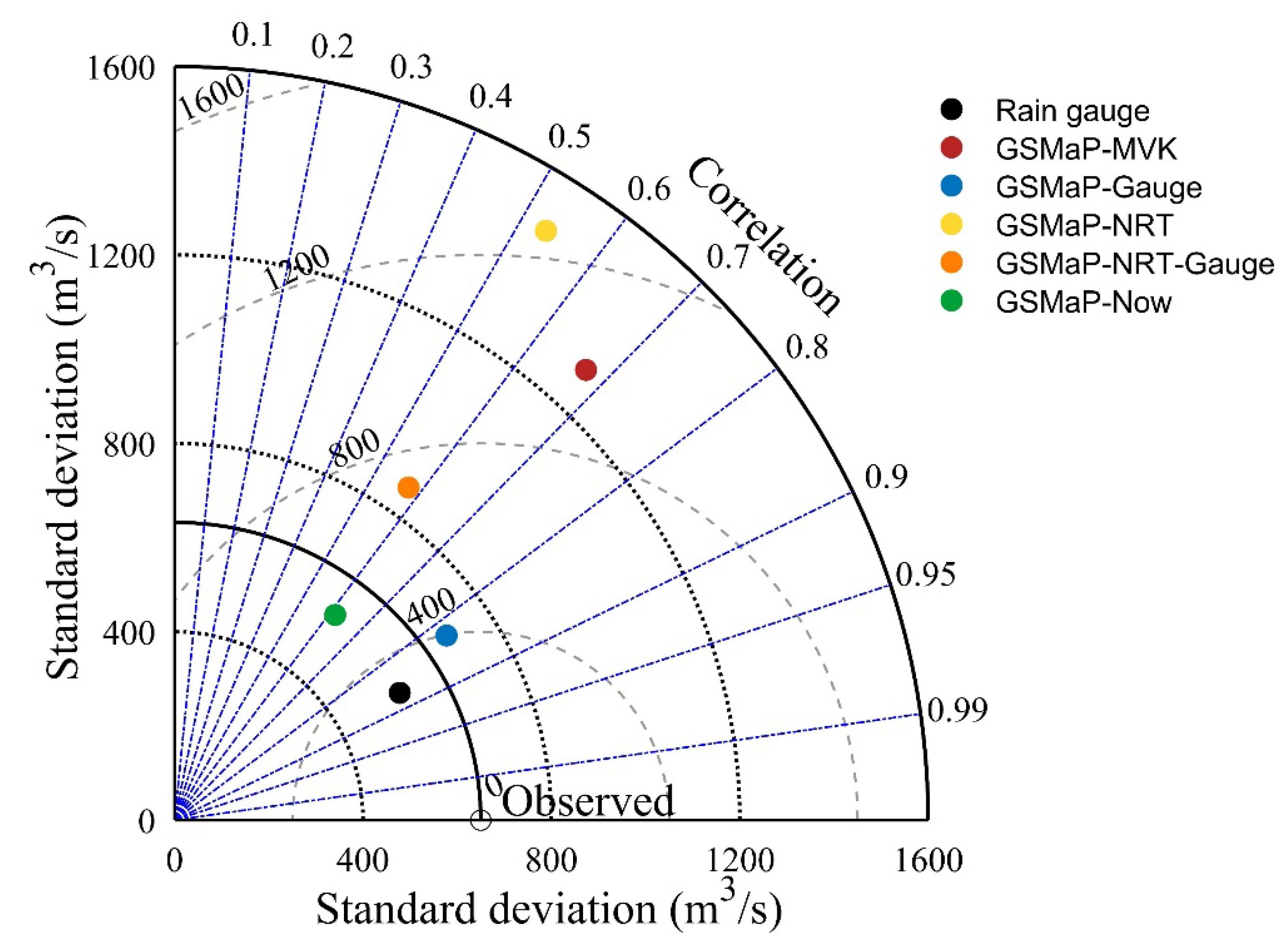
| SPPs | Coverage | Spatiotemporal Resolution | Latency | Start Time | Gauge-Based Correction |
|---|---|---|---|---|---|
| GSMaP-MVK | 60°N–60°S | 1 h, 0.1° | 3 days | 1 March 2014 | No |
| GSMaP-Gauge | 60°N–60°S | 1 h, 0.1° | 3 days | 1 March 2014 | Yes |
| GSMaP-NRT | 60°N–60°S | 1 h, 0.1° | 4 h | 17 January 2017 | No |
| GSMaP-NRT-Gauge | 60°N–60°S | 1 h, 0.1° | 4 h | 17 January 2017 | No |
| GSMaP-Now | 60°N–60°S | 30 min, 0.1° | 0 h | 29 March 2017 | No |
| Categories | Diagnostic Indices | Formulas | Unit | Perfect Value |
|---|---|---|---|---|
| Indices for quantifying the accuracy of GSMaP SPPs versus ground precipitation observations | Relative bias of total precipitation (RBP) | % | 0 | |
| Pearson correlation coefficient (CC) | – | 1 | ||
| Relative root-mean-squared error (RRMSE) | % | 0 | ||
| Probability of detection (POD) | – | 1 | ||
| False alarm ratio (FAR) | – | 0 | ||
| Critical success index (CSI) | – | 1 | ||
| Indices for quantifying the hydrological performance of GSMaP SPPs | Relative bias of total runoff (RBR) | % | 0 | |
| Nash-Sutcliffe model efficiency coefficient (NSE) | – | 1 | ||
| Relative bias of flood peak flow (RBFP) | % | 0 | ||
| Error of flood peak time (EPT) | hours | 0 |
| Time Period | Precipitation Input | RBR (%) | NSE |
|---|---|---|---|
| 1 March 2014–31 December 2018 | Gauge | 8.0 | 0.760 |
| GSMaP-Gauge | 24.0 | 0.613 | |
| GSMaP-MVK | 169.1 | −6.316 | |
| 29 March 2017–31 December 2018 | Gauge | 6.4 | 0.805 |
| GSMaP-Gauge | 25.9 | 0.630 | |
| GSMaP-MVK | 153.5 | −5.053 | |
| GSMaP-NRT | 111.2 | −3.307 | |
| GSMaP-NRT-Gauge | 36.1 | 0.104 | |
| GSMaP-Now | −21.5 | 0.380 |
| Flood Events | Precipitation Inputs | Precipitation (mm) | RBP (%) | RBR (%) | NSE | RBFP (%) | PTE (h) |
|---|---|---|---|---|---|---|---|
| 20140907 | Gauge | 114.4 | - | −19.9 | 0.551 | −23.3 | 1 |
| GSMaP-Gauge | 112.9 | −1.4 | −16.8 | 0.641 | −21.9 | 1 | |
| GSMaP-MVK | 162.8 | 42.3 | 73.1 | −4.635 | 81.4 | 0 | |
| 20150622 | Gauge | 117.4 | - | 16.9 | 0.585 | −3.5 | −13 |
| GSMaP-Gauge | 130.9 | 11.5 | 41.5 | −0.912 | 19.0 | −12 | |
| GSMaP-MVK | 187.8 | 60 | 191.1 | −38.78 | 149.9 | −104 | |
| 20150921 | Gauge | 36.2 | - | 2.6 | −0.168 | −1.6 | −17 |
| GSMaP-Gauge | 40.5 | 12.1 | 30.6 | −16.682 | 30.7 | −18 | |
| GSMaP-MVK | 92.9 | 156.8 | 260.9 | −1076.51 | 348 | −15 | |
| 20161011 | Gauge | 16.6 | - | −0.7 | 0.590 | −9.7 | −81 |
| GSMaP-Gauge | 20.1 | 20.9 | 23.1 | −0.848 | 13.3 | −83 | |
| GSMaP-MVK | 25.3 | 52.1 | 156.9 | −70.094 | 140.6 | −89 | |
| 20170527 | Gauge | 160.6 | - | 27.9 | −0.071 | −5.2 | −56 |
| GSMaP-Gauge | 172.3 | 7.2 | 43.2 | −1.138 | 7.0 | −47 | |
| GSMaP-MVK | 156.1 | −2.8 | 85.5 | −7.393 | 33.2 | −353 | |
| GSMaP-NRT | 160.0 | −0.4 | 65.8 | −5.735 | 46.0 | −385 | |
| GSMaP-NRT-Gauge | 170.2 | 5.9 | 46.1 | −2.166 | 6.3 | −362 | |
| GSMaP-Now | 81.9 | −49.0 | −30.0 | −0.765 | −48.0 | −350 | |
| 20170821 | Gauge | 220.7 | / | 6.7 | −0.025 | −2.6 | −824 |
| GSMaP-Gauge | 258.1 | 16.9 | 36.3 | −1.523 | 18.7 | −620 | |
| GSMaP-MVK | 358.1 | 62.2 | 198.2 | −53.42 | 185.8 | −68 | |
| GSMaP-NRT | 362.5 | 64.2 | 208.4 | −66.186 | 263.8 | −29 | |
| GSMaP-NRT-Gauge | 273.4 | 23.8 | 81.2 | −12.52 | 112.3 | −842 | |
| GSMaP-Now | 155.9 | −29.4 | −14.3 | −1.245 | 8.5 | −860 | |
| 20180625 | Gauge | 148.4 | / | 2.1 | 0.607 | −18.3 | −68 |
| GSMaP-Gauge | 157.6 | 6.2 | 31.3 | −0.555 | 6.3 | −12 | |
| GSMaP-MVK | 190.8 | 28.5 | 65.8 | −5.76 | 25.8 | −8 | |
| GSMaP-NRT | 197.5 | 33.0 | 45.8 | −2.87 | 13.8 | 249 | |
| GSMaP-NRT-Gauge | 171.3 | 15.4 | −2.9 | −0.171 | −15.9 | 249 | |
| GSMaP-Now | 118.6 | −20.1 | −18.9 | −0.128 | −34.2 | −9 | |
| 20180829 | Gauge | 128.7 | / | −12.5 | −0.038 | −15.8 | −282 |
| GSMaP-Gauge | 140.2 | 8.9 | −14.7 | 0.04 | −12.2 | −11 | |
| GSMaP-MVK | 180.8 | 40.4 | 74.7 | −22.888 | 147.0 | −151 | |
| GSMaP-NRT | 169.5 | 31.7 | 58.4 | −14.055 | 80.4 | −276 | |
| GSMaP-NRT-Gauge | 145.1 | 12.7 | 19.7 | −2.387 | 45.0 | −280 | |
| GSMaP-Now | 69.3 | −46.2 | −59.4 | −13.136 | −45.7 | −251 |
Publisher’s Note: MDPI stays neutral with regard to jurisdictional claims in published maps and institutional affiliations. |
© 2021 by the authors. Licensee MDPI, Basel, Switzerland. This article is an open access article distributed under the terms and conditions of the Creative Commons Attribution (CC BY) license (https://creativecommons.org/licenses/by/4.0/).
Share and Cite
Shi, J.; Wang, B.; Wang, G.; Yuan, F.; Shi, C.; Zhou, X.; Zhang, L.; Zhao, C. Are the Latest GSMaP Satellite Precipitation Products Feasible for Daily and Hourly Discharge Simulations in the Yellow River Source Region? Remote Sens. 2021, 13, 4199. https://doi.org/10.3390/rs13214199
Shi J, Wang B, Wang G, Yuan F, Shi C, Zhou X, Zhang L, Zhao C. Are the Latest GSMaP Satellite Precipitation Products Feasible for Daily and Hourly Discharge Simulations in the Yellow River Source Region? Remote Sensing. 2021; 13(21):4199. https://doi.org/10.3390/rs13214199
Chicago/Turabian StyleShi, Jiayong, Bing Wang, Guoqing Wang, Fei Yuan, Chunxiang Shi, Xiong Zhou, Limin Zhang, and Chongxu Zhao. 2021. "Are the Latest GSMaP Satellite Precipitation Products Feasible for Daily and Hourly Discharge Simulations in the Yellow River Source Region?" Remote Sensing 13, no. 21: 4199. https://doi.org/10.3390/rs13214199
APA StyleShi, J., Wang, B., Wang, G., Yuan, F., Shi, C., Zhou, X., Zhang, L., & Zhao, C. (2021). Are the Latest GSMaP Satellite Precipitation Products Feasible for Daily and Hourly Discharge Simulations in the Yellow River Source Region? Remote Sensing, 13(21), 4199. https://doi.org/10.3390/rs13214199






